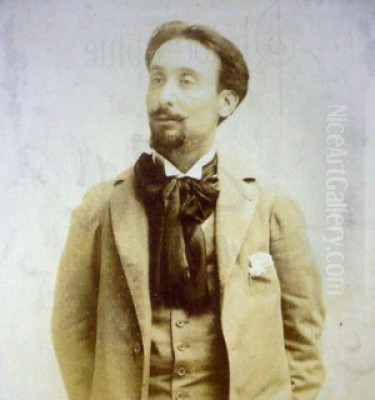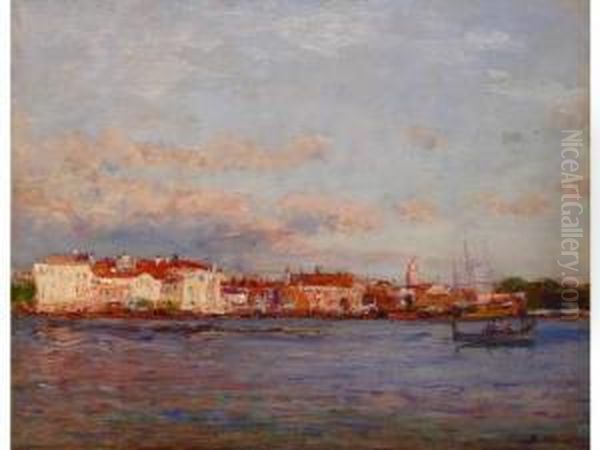
Louis Nattero stands as a significant figure in the artistic landscape of Provence, particularly renowned for his evocative depictions of the bustling Old Port of Marseille. Active during the vibrant period of the late nineteenth and early twentieth centuries, Nattero captured the unique atmosphere of his native city with a distinctive style that blended keen observation with dramatic flair. His life, tragically cut short, coincided with a period of rich artistic development in France, and his work provides a fascinating window into the maritime heart of Marseille.
Early Life and Artistic Formation
Born in Marseille in 1870, Louis Marius Nattero grew up immersed in the sights and sounds of the Mediterranean port city that would become the central subject of his artistic career. The vibrant maritime life, the unique quality of light, and the bustling energy of the Vieux-Port undoubtedly made a profound impression on the young artist. His formal artistic training took place within this stimulating environment, grounding his later work in the specific visual language of his hometown.
Nattero pursued his studies at the École des Beaux-Arts in Marseille, a crucial institution for nurturing regional talent. Here, he honed his technical skills in drawing and painting. A key figure in his development was the painter Jean-Baptiste Olive (1848-1936), himself a celebrated artist known for his luminous seascapes and depictions of the Provençal coast. Studying under Olive likely reinforced Nattero's inclination towards maritime subjects and sharpened his sensitivity to light and atmosphere.
The École de Marseille and Provençal Art
Louis Nattero is often associated with the École de Marseille (School of Marseille), though this term refers less to a formal institution and more to a loosely connected group of artists active in the region from the mid-nineteenth century onwards. These artists shared a common interest in depicting the landscapes, light, and life of Provence, moving away from the academic constraints often favoured in Paris. The movement's roots can be traced back to figures like Émile Loubon (1809-1863), who encouraged painting directly from nature.

The Marseille School encompassed several generations and stylistic variations. Earlier influential figures included the highly individualistic Adolphe Monticelli (1824-1886), known for his richly textured, almost dreamlike scenes. Nattero's contemporaries within this regional milieu included artists like Alfred Casile (1848-1909), Valère Bernard (1860-1936), Marius Guindon (1831-1918), and Raphaël Ponson (1835-1904), each contributing to the diverse artistic identity of Provence. They collectively celebrated the unique character of the South of France.
Nattero's Distinctive Style: Light and Nocturne
While situated within the broader context of Provençal painting, Louis Nattero developed a highly personal and recognizable style. His primary fascination lay with the Old Port of Marseille, which he painted repeatedly, exploring its varied moods and activities, particularly during the transitional hours of twilight and the deep of night. This focus on nocturnal scenes became a hallmark of his work, setting him apart from many contemporaries who concentrated on the bright sunlight of the Midi.
Nattero masterfully employed chiaroscuro, the dramatic interplay of light and shadow, to convey the port's atmosphere after dark. Gaslights, lanterns on boats, and reflections shimmering on the water's surface punctuate his compositions, creating focal points within the prevailing darkness. His brushwork is often energetic and expressive, applying paint thickly in places (impasto) to capture the texture of stone quays or the choppy surface of the water, lending a tactile quality to his canvases.
His palette, while capable of capturing the lingering colours of sunset, often favoured deep blues, greens, and blacks, contrasted with touches of yellow, orange, and white for the artificial lights and their reflections. This approach differed significantly from the high-keyed palettes often associated with Impressionism, though his interest in capturing fleeting effects of light and atmosphere certainly connects him to the broader concerns of late 19th-century French painting. Artists like Claude Monet (1840-1926) had explored nocturnal effects, but Nattero made the Marseille night his own specific territory.
The Vieux-Port: A Constant Muse
The Old Port of Marseille was more than just a backdrop for Nattero; it was his central protagonist. His paintings document the lifeblood of the city: fishing boats returning at dusk, larger vessels docked along the quays, the silhouettes of warehouses and historic buildings like Fort Saint-Jean against the fading light. He captured not just the physical structures but the human element – the dockworkers, the sailors, the sense of constant movement and maritime commerce.
His works often bear titles that directly reference his subject, such as "Le Vieux-Port de Marseille," "Effet de Nuit sur le Port," or "Barques au Crépuscule." These paintings are valuable not only as artistic achievements but also as historical documents, preserving a vision of the port at a specific moment in time, before later transformations. Nattero’s dedication to this single, albeit rich, subject allowed him to explore it with depth and nuance, revealing its changing character under different lighting conditions and times of day.
The intensity of his focus on the port echoes the dedication other artists showed to their own signature subjects – Paul Cézanne (1839-1906), another Provençal native, with Mont Sainte-Victoire, or Edgar Degas (1834-1917) with dancers. Nattero found endless inspiration in the interplay of water, vessels, architecture, and light within the confines of the Marseille harbour.
Nattero in the Wider Art World
Louis Nattero worked during a period of immense artistic innovation in France and Europe. Impressionism had revolutionized painting decades earlier, and its legacy was being extended and challenged by Post-Impressionist movements. Artists like Vincent van Gogh (1853-1890), who spent a crucial period in nearby Arles, explored expressive colour and brushwork. Paul Signac (1863-1935), a key figure in Neo-Impressionism, was also drawn to the light and ports of the South of France, including Marseille and Saint-Tropez, developing his pointillist technique.
While Nattero's style remained distinct, it absorbed elements from these contemporary currents. His expressive handling of paint and focus on subjective atmosphere align him broadly with Post-Impressionist sensibilities, rather than the more objective optical approach of earlier Impressionists like Camille Pissarro (1830-1903) or Pierre-Auguste Renoir (1841-1919). Furthermore, the emergence of Fauvism in the early 20th century, with figures like Henri Matisse (1869-1954) and André Derain (1880-1954) using bold, non-naturalistic colour, marked another radical shift during Nattero's lifetime, though his own work did not embrace this level of chromatic abstraction.
Nattero remained primarily a regional artist, deeply rooted in Marseille. While perhaps not achieving the international fame of the Parisian avant-garde, his work represents an important facet of French painting at the turn of the century, demonstrating the vitality of artistic centres outside the capital. He successfully translated the universal language of light and atmosphere into the specific dialect of his beloved port.
Later Years and Legacy
Louis Nattero continued to paint actively into the early twentieth century, refining his vision of the Marseille port. His dedication to his subject matter remained unwavering. His life and promising career, however, were tragically cut short. Louis Nattero died in 1915, during the first years of World War I, at the relatively young age of 45. The exact circumstances of his death are sometimes linked to the conflict, though details can be scarce.
Despite his premature death, Nattero left behind a substantial body of work that secured his reputation, particularly in Southern France. His paintings are held in regional museums, including the Musée des Beaux-Arts de Marseille, and are sought after by collectors interested in Provençal art and maritime scenes. He is remembered as one of the most compelling interpreters of the Old Port, especially its nocturnal beauty.
His legacy lies in his ability to capture the soul of Marseille's maritime heart. Through his dramatic use of light and shadow, his energetic brushwork, and his deep familiarity with his subject, Louis Nattero created a powerful and enduring portrait of the Vieux-Port at the turn of the twentieth century. He remains a key figure for understanding the artistic heritage of Marseille and the broader traditions of French landscape and marine painting. His work continues to resonate with viewers drawn to the atmospheric allure of the Mediterranean night.